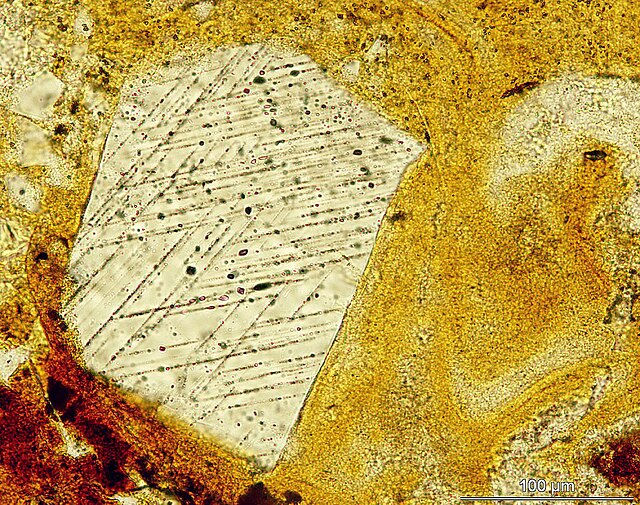Top Qs
Timeline
Chat
Perspective
Meteorite shock stage
Measure of the degree of fracturing of the matrix of a common chondrite meteorite From Wikipedia, the free encyclopedia
Remove ads
Meteorite shock stage is a measure of the degree of fracturing of the matrix of a common chondrite meteorite.[1] Impacts on the parent body of a meteoroid can produce very large pressures. These pressures heat, melt and deform the rocks. This is called shock metamorphism. Meteorites are often given a rating from 1 to 6 showing the level of shock metamorphism. However, the degree of shock can vary within a meteorite on the scale of centimeters.[2]

Smaller bodies colliding with one another would not have sufficiently great impact velocity to produce the pressures and temperatures required to produce shock effects, due to their lesser gravitational attraction for one another. High instantaneous pressures, in excess of 5 GPa (1 GPa = 10,000 atmospheres), are necessary to produce shock metamorphism.
Remove ads
Shock grade
Summarize
Perspective


The fracturing of crystals and other features must be observed under a microscope with shock effects observed under polarized light. Larger structures, such as shock veins, are visible to the eye. Many of the shocked veins formed at the boundaries of polished surfaces of brecciated specimens exhibit intricate spider-web-like structures. Following is a summary of the shock grades:[3]
- S1: completely unshocked (up to 5 GPa)
- S2: very weakly shocked (5-10 GPa); uneven darkening of olivine as seen under polarized light; planar and irregular fractures (breaks in other than a natural cleavage plane.)
- S3: weakly shocked (15-20 GPa); weak fractures in olivine seen under polarized light; dark shock veins and some melt pockets
- S4: moderately shocked; (30-35 GPa); weak planar fracturing of olivine under polarized light; some pockets of melted material, dark interconnected shock veins
- S5: strongly shocked (45-55 GPa); very strong planar fracturing and deformation features in olivine; alteration of plagioclase into maskelynite; formation of dark melt veins
- S6: very strongly shocked (75-90 GPa); olivine recrystallizes, with local alteration to a mineral called ringwoodite and shock melting of plagioclase to a glass
Greater shock pressures will melt the rock, producing what is referred to as an "impact melt". These are seldom found on Earth, so they are very much sought after by collectors.
Remove ads
See also
References
Wikiwand - on
Seamless Wikipedia browsing. On steroids.
Remove ads
